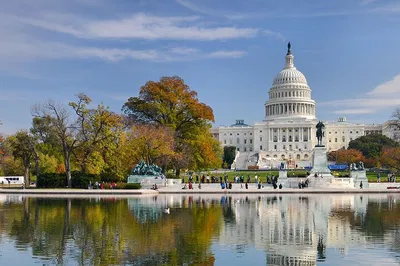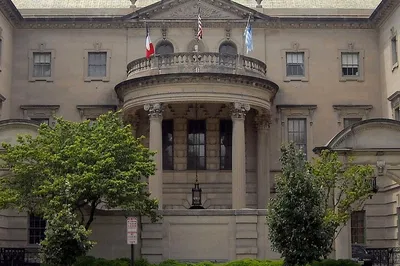Gettysburg, Shiloh & More: Battlefields Audio Tour
7200
Overview
Iconic Battlefields Audio Tour: Gettysburg, Shiloh & More offers a deep dive into American history. This self-guided audio tour lets you explore the key battles of Gettysburg, Antietam, and Vicksburg. Discover the stories behind the Revolutionary War and the bloody battles of the Civil War, where Americans fought each other. Hear tales of generals, everyday heroes, and the events that shaped these conflicts.
See the Gettysburg Heritage Center Museum, McPherson's Ridge, and the Eternal Light Peace Memorial. Walk through the Wheat Fields and visit Little Round Top, key locations in the Battle of Gettysburg. The tour continues to Antietam National Battlefield, including Burnside Bridge and the Mumma Farmstead. Finally, it concludes at Vicksburg Battlefield, with landmarks like the Memorial Arch and the Illinois Memorial.
This car tour includes an easy-to-use app with offline maps. Listen to engaging stories as you drive, and go at your own pace, stopping for breaks and photos whenever desired. This tour provides a comprehensive route that ensures that you see everything and miss nothing! This experience offers an affordable way to see historical battlefields with professional narration.
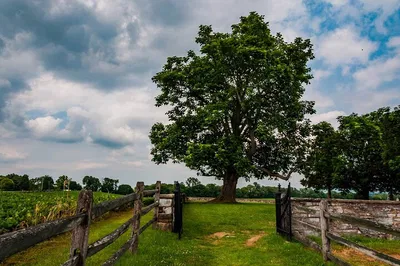
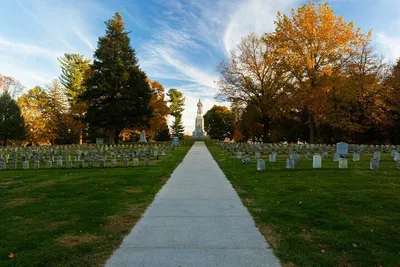
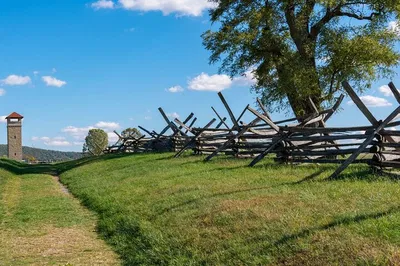

Highlights
Go at Your Own Pace: Start, stop, and explore whenever you want!
Offline Maps: No internet? No problem! The tour works perfectly offline.
Engaging Stories: Hear exciting stories and learn about the history of the battlefields.
Great Value: Pay per car, not per person! Save money compared to bus tours.
Sentiment Analysis
Customers generally found the audio tour to be a worthwhile and educational experience, praising its convenience and informative content. However, some technical issues with the app and unclear directions were noted.

Customers enjoyed the flexibility of touring at their own pace.
The audio guide is very informative and well-narrated.
The tour is a great value for the price.
It is perfect for those who want to learn more about the history of the battlefields.
Some users experienced technical difficulties with the app download.
Some visitors wished for clearer directions at certain stops.
The Journey
Gettysburg Heritage Center Museum
Begin your Gettysburg experience at the Gettysburg Heritage Center Museum, offering a comprehensive introduction to the battle's context and consequences. Discover interactive exhibits, artifacts, and personal stories that bring the civilian experience of the Civil War to life. Understand the events leading up to the battle and its lasting impact on the community and the nation.
McPherson's Ridge
Witness the dawn of the Battle of Gettysburg at McPherson's Ridge, where the initial clashes between Union and Confederate forces unfolded. Imagine the strategic movements of troops and the desperate fighting as you overlook this crucial terrain. Reflect on the decisions made by generals on both sides that shaped the course of the battle's first day.
Railway Cut
Explore the Railway Cut, an unlikely site of a major skirmish during the first day of Gettysburg. Analyze the different battle strategies employed by Union and Confederate generals in this confined space. Delve into the backstories of key battlefield players and understand the tactical significance of this location.
Eternal Light Peace Memorial
Pass by the Eternal Light Peace Memorial, a symbol of reunification and hope after the Civil War. Admire the memorial's construction, using Maine granite and Alabama limestone to represent the symbolic unification of North and South. Reflect on the memorial's message of peace and reconciliation, honoring the efforts to heal the nation's wounds.
Oak Ridge Observation Tower
Ascend the Oak Ridge Observation Tower for panoramic views of the Gettysburg battlefield and a vantage point over the historic fields. Step back in time to the afternoon of the first day of battle and "join" the fight as Union soldiers try to hold off the Confederate advance. Gain a comprehensive understanding of the battlefield layout and the strategic importance of Oak Ridge.
11th Pennsylvania Infantry Monument (Battlefield Sallie)
Pay your respects at the 11th Pennsylvania Infantry Monument and discover the story of Battlefield Sallie, the loyal canine mascot who accompanied the Union soldiers throughout much of the Civil War. Learn about the importance of drummers and military music during the war, adding a unique and personal touch to the battlefield experience. The statue of Sallie is a reminder of the human-animal bond amidst the brutality of war.
Gettysburg Battlefield
As evening descends on the first day, explore the plans and strategies that generals came up with while they bunker down. Learn about the various tactical plans created and utilized by Union and Confederate troops alike.
North Carolina Memorial and Virginia Monument
Drive past the North Carolina Memorial and Virginia Monument, each dedicated to the soldiers from these states who fought at Gettysburg. Reflect on the sacrifices made by soldiers on both sides of the conflict, and understand the complex motivations and allegiances that defined the Civil War.
Gettysburg Battlefield Auto Road
Continue your journey along the Gettysburg Battlefield Auto Road, and enter the second day of the battle. Troops on both sides have begun to organize and mobilize; imagine the tension and anticipation as both sides prepared to engage. Whose strategy will finally succeed?
Longstreet Observation Tower
Visit Longstreet Observation Tower, which offers a great vantage point over the second day's battlefield. Experience the landscape from the same elevated perspective that General Longstreet would have had during the second day of battle.
Eisenhower National Historic Site
Take an optional detour to the Eisenhower National Historic Site, offering a glimpse into the post-presidency life of Dwight D. Eisenhower and the site of his weekend retreat. Explore the farm and learn about Eisenhower's role in American history, as well as his connection to the Gettysburg battlefield, where he occasionally hosted world leaders.
Gettysburg Battlefield
Travel the Gettysburg Road and follow the activities of Day 2 of the battle. Confederate troops assemble, ready to attack one of the strategic Union outposts. Specially trained Union marksmen are in a position to defend; the stage is set.
Little Round Top
Though currently inaccessible, virtually experience Little Round Top. Explore the heroic actions that changed the war's course, and learn about the brave soldiers who fought and died there. Understand the strategic importance of the hill through vivid stories and images.
Devil's Den
Explore Devil's Den, a landscape of jagged rocks and strategic importance. Envision Confederate sharpshooters using the natural cover to inflict casualties on the Union side. Understand the brutal realities of Civil War combat and the challenges faced by soldiers on both sides.
Wheat Fields
Drive along the Gettysburg Auto Road, passing the Wheat Fields. Transport yourself to the heat of battle, fighting alongside Union soldiers to defend against the Confederates. Learn about the strange tale of Union soldier JJ Purman.
Peach Orchard
Pass by the Peach Orchard, the site of intense fighting on the second day of the battle. Analyze the strategies that were successful and those that failed as you drive past. Reflect on the human cost of the battle and the impact on the landscape.
Trostle Farm
Reflect on the civilian experience of the battle at the Trostle Farm, where the family fled their home so abruptly that dinner was still on the table. Understand the disruption and fear experienced by the local population during the battle, and the lasting impact on their lives and community.
Plum Run
Journey along the Gettysburg Battlefield Auto Road to Plum Run, and imagine the soldiers who just escaped the skirmish at the Peach Orchard. Understand the landscape of the era, as well as the dangers that soldiers faced.
George Weikert Farm
Visit the George Weikert Farm, which transformed into a battlefield hospital after the Weikert family hastily evacuated. Learn about military doctors and the effects of war as you drive, bringing to life the grim realities of Civil War medicine and the challenges faced by medical personnel.
Pennsylvania Memorial
Visit the Pennsylvania Memorial, honoring the nearly 35,000 Pennsylvanian soldiers who fought at Gettysburg. Reflect on the particular stakes for these men, fighting for their very state. Understand the importance of local identity and loyalty during the Civil War.
Spangler's Spring and Culp's Hill Tower
Discover Spangler's Spring and Culp's Hill Tower, sites of strategic importance during the battle. Dive into the significance of this small but mighty site, and understand how Union and Confederate soldiers clashed again, fighting for control of this strategic outpost.
East Cemetery Hill
Explore East Cemetery Hill, the site of a Confederate nighttime raid on the second day of battle. Understand the moment when the Union came closest to losing, and appreciate the mixture of perseverance, skill, and luck that led to their victory. Reflect on the significance of this historic site as the second day of battle comes to a close.
Pickett's Charge (Confederate High Water Mark)
Stand atop the hill overlooking the expanse of the final battlefield. Follow the progress of this last charge, and take a look at the "high water mark" -- the spot that marks the farthest the Confederacy advanced up the hill, towards the Union defenses.
Gettysburg National Cemetery
Visit the Gettysburg National Cemetery, the final resting place for fallen Union soldiers who defended their country. Pay your respects and reflect on their sacrifice. Understand the dedication of Abraham Lincoln's Gettysburg Address.
Gettysburg Address Memorial
Reflect on the power and brevity of President Abraham Lincoln's Gettysburg Address at the site where it was delivered. Given the monumental nature of the battle, most people expected President Lincoln to deliver quite a lengthy speech. But Lincoln didn’t want to steal attention that he believed belonged to the Union soldiers who sacrificed their lives here.
Antietam National Battlefield
Begin your exploration of the Antietam National Battlefield, a National Park Service-protected area commemorating the American Civil War Battle of Antietam. Learn about the historical context of the battle and its significance in shaping the course of the war. Understand the human cost of the conflict and the impact on the surrounding community.
Major General Joseph Mansfield Monument
Visit the monument dedicated to Major General Joseph Mansfield, and imagine him leading his untrained battalion, and his mortal chest wound. Understand how soldiers felt without their commander.
West Woods
Explore the West Woods, where 5,000 Union soldiers charged, hoping to repeat the easy victory their comrades found in the East Woods. Experience the desperate, life-or-death struggle between the Union and Confederate troops.
Mumma Farmstead
See the Mumma farmstead, set ablaze by retreating Confederate troops to deny cover to the Union forces. Reflect on the destruction and loss experienced by civilian families caught in the path of war. Consider the impact of the conflict on the local community and its long-term consequences.
Irish Brigade Monument
Visit the Irish Brigade Monument, honoring the Irish Americans who fought at the Bloody Lane. Understand the importance of the battle and how everything hinged on a Union victory.
Piper Farm
Visit Piper Farm, used as Confederate headquarters during the battle. Imagine Confederate generals using this farm as their headquarters, planning each attack, each defensive line, looking for a way to emerge victorious.
Burnside Bridge
Visit Burnside Bridge, where another wildly unbalanced struggle took place. Consider the brutal conditions of battle, and imagine the Union soldiers' attempts to take the bridge and the fierce Confederate defense.
McKinley Monument
Visit the McKinley Monument, which honors the future 25th President of the United States, and recalls a story of the boy's odd brand of heroism following the brutal struggle on the bridge.
General Burnside
Fun fact! Sideburns are named after General Burnside. Once you look at his portrait, there’s really no need to guess why!
Antietam Battlefield
Visit the site from which the Union forces assembled and launched their final attack against the Confederate lines, which by now have been forced to fall back repeatedly. Watch the tumult of battle and gunfire, hear the beating of drums and the war cries, and, finally, see what is left after the dust clears.
9th New York Infantry Monument
Take an optional detour to a monument honoring the 9th New York Infantry, who almost broke through the final Confederate line in an attack which could have changed the rest of the war--but didn't quite succeed.
Tolson Chapel
Take another detour to Tolson Chapel, built by Black Americans just one year after the war ended.
Piper House
Our next optional stop is Piper House, one of Sharpsburg’s oldest houses. It gives us a glimpse into what the town was like even before the Civil War put it on the map.
Mount Calvary Lutheran Cemetery
This detour brings us to the Mount Calvary Lutheran Cemetery, which dates all the way back to 1768. During the battle, Confederates used the now-demolished church next to this cemetery to send orders and information to troops across the battlefield. And afterward, the Union used the same church as a field hospital!
Antietam National Cemetery
Visit the Antietam National Cemetery, where the remains of 4,776 Union soldiers rest alongside about 200 dead from other wars. Pay your respects to those who fought and died for the Union cause, and honor their sacrifice in preserving the nation.
Vicksburg Battlefield
Welcome to the Vicksburg Battlefield! Understand why it was so important, what happened here, and what it all meant. Learn about President Abraham Lincoln, this site was the key to winning the entire Civil War.
Memorial Arch
Drive toward the Memorial Arch, built after a veterans reunion was held here in 1917. Former soldiers from both sides of the war sat side by side at this historic 4-day event. This time they sat in peace. It was certainly a bittersweet moment and one the veterans wanted to commemorate. So they built this arch!
Minnesota Memorial
Park near that pillar memorial coming up ahead on our left. That’s the Minnesota Memorial. The statue at the base of the pillar is a statue of peace. She holds a sword and shield that have since been laid down by both armies. They’re in her hands for safe keeping, preventing any future battles on this soil.
Michigan Memorial
The soaring obelisk around the bend and to our left is the Michigan Memorial. The statue at its base is “The Spirit of Michigan.” This memorial honors the Michigan men who fought here, but its location is of particular importance. One of their leaders, Captain Samuel DeGolyer, was mortally wounded near here during the fighting on the 28th of May. I’ll talk in more detail about that soon.
Illinois Memorial
The man who designed this monument was W. L. B. Jenney, a veteran who actually fought in the battle here! Inside, we’ll find the names of every Illinois soldier who fought here. Jenney intended to create not just a memorial, but a temple to those brave souls, many of whom gave their lives for their country on this battlefield.
Logan’s Approach
The trench beyond this parking lot is known as Logan’s Approach. Here, Union engineers tried an unusual tactic to advance on a Confederate position during the fighting. Under General Grant’s orders, they dig a trench to the Confederate fort. Then they place a mine laden with 2,200 pounds of gunpowder in the trench and light the fuse!
Wisconsin Memorial
That’s the Wisconsin Memorial. Direct your eyes at the top of this monument, and there’s ‘Old Abe,’ war eagle and official mascot for the 8th Wisconsin Infantry. Believe it or not, Old Abe was a real bird! The 8th WIsconsin would carry him proudly onto the battlefield, tethered to a five-foot poll painted red, white and blue. He was a good old bird, granted honorable discharge in 1864. A true war veteran who witnessed 42 battles!
West Virginia Monument
The bust we’re about to pass on our right is the West Virginia Monument, which honors Major Azra Goodspeed. Goodspeed was born in Ohio, but served and was killed fighting for West Virginia. Quite a few men from Ohio and Pennsylvania actually fought under the West Virginia flag. That’s because when recruitment numbers were filled, new recruits looked for other states with open positions.
African-American Soldiers Memorial
This memorial honors the thousands of African-American soldiers who fought for the Union and for their freedom. And yet, all was not equal, even in the Union army. Units were segregated and Black soldiers were paid less and given worse equipment. But still they fought shoulder to shoulder with their white comrades in the heat of battle.
Major General Ulysses S. Grant Statue
That statue depicts none other than the man himself, Major General Ulysses S. Grant. It’s impossible to miss! Park in the lot when you see it.
106th Volunteer Infantry Regiment Monument
We’re about to pass a monument honoring the 106th Volunteer Infantry Regiment from Illinois. It’s the small granite obelisk coming up on our right. These men trained in Lincoln, Illinois, where Abraham Lincoln once worked as a lawyer!
US Navy Monument
The tallest monument in the park is coming up soon. It’s the US Navy Monument, honoring the officers and sailors who fought in Vicksburg. Grant’s army gets most of the credit for the siege of Vicksburg, but he couldn’t have done it without help from the Navy. The gunboats brought Grant’s men down the Mississippi. They sneaked past rebel defense lines in the dead of night. They carried Grant’s army across the Mississippi at Bruinsburg.
Vicksburg National Cemetery
This is the Vicksburg National Cemetery, the final resting place for 17,000 Union soldiers. For many, it’s their second burial ground. How come? During the war when a soldier was killed, their comrades dug a grave close to the action. There wasn’t time to do anything else! A simple wooden cross with their name carved on it sufficed as a grave marker. Hundreds of markers like that dotted the landscape. When the war ended, the US government tried their best to locate all these markers and made every effort to give these men a proper burial.
Fort Hill
This is Fort Hill, and what a view it offers! It's not hard to imagine why Confederates were stationed here. Open landscape, clear views of the river, and a bend that caused warships to slow down. A perfect lookout point. In fact, Fort Hill was so well fortified that no land battle ever took place here. It was that secure.
Missouri Memorial
On our left stands the Missouri Memorial, representing both sides of the Civil War. Missouri was a state divided. Both the Union and the Confederacy recognized it as their own. 109,000 men joined the Union, 30,000 joined the Confederacy. Neighbors turned against one another.
Mississippi Monument
The stone obelisk coming up on our right is the Mississippi monument. Like a few other memorials on this battlefield, the base of this one is adorned with the figure of a woman. But who is she, and why is she here? The women on these monuments serve as protectors to the warriors. They’re modeled after Greek or Roman goddesses representing peace and reconciliation.
Alabama Monument
The bronze monument coming up on our right commemorates troops from the state of Alabama. The men depicted here are being led forward by a woman who represents the state of Alabama itself.
Fort Garrott
The hill on our left was the site of Fort Garrott. Who’s the fort named after? Colonel Isham W. Garrott that’s who! He was the commander of a volunteer regiment from Alabama. Fort Garrott is never blasted like other forts. But Union snipers hide behind trees, waiting to shoot any sign of movement. One day, Garrott himself moves. A bullet kills him instantly. He never knew he’d just been promoted to Brigadier General.
Kentucky Monument
From here we can see the Kentucky Monument. This iconic memorial depicts two essential figures: Abraham Lincoln and Confederate President Jefferson Davis. Both men were born in Kentucky, so the bluegrass state honors them both.
Shiloh Visitor Center
Begin your journey at the Shiloh Visitor Center, the ideal starting point to delve into the significance of the Civil War battle that once razed these fields. Learn about the landmarks and events that testify to its ferocity.
Iowa State Monument
The monument to our right is the Iowa State Monument. The soaring bird atop this granite tower is an eagle caught in mid-flight, representing the freedom of the soul. That bronze figure in the flowing robe depicts Fame. The 12-foot statue holds a quill pen to the monument, carving an elegy on the battlefield for posterity.
Grant's Last Line
These cannons mark the site of Grant’s Last Line. Picture this: Dusk is about to fall on a warm April day. Men drag iron siege guns that are so heavy, they usually require oxen to move. 20,000 troops mustered from all different brigades gather right here. This is General Ulysses S. Grant’s Last Line, the desperate last-ditch attempt to hold back the relentless surge of the Confederate side.
Michigan Monument
The soldier commemorates the 353 troops from Michigan who were killed, wounded, or missing during the battle of Shiloh.
Daughters of the Confederacy Monument
This is the Daughters of the Confederacy Monument. General Albert Sidney Johnston led the Confederate forces here in Shiloh.
Shiloh Church and Cemetery
Today, we’ll see two structures here: A modern church, and an authentic replica of the original. The new one is a large 1950s building with green shingles, brick and stone siding, and a tall white steeple. The replica is a one-room log cabin. It’s around this cabin where General Sherman and his men have made camp.
Yorktown Battlefield Visitor Center
Begin your exploration of the Yorktown Battlefield at the Visitor Center, offering a comprehensive introduction to the final major battle of the American Revolutionary War. Learn about the strategies, leaders, and key events that led to American independence.
Moore House
Visit the Moore House, where Cornwallis and Washington send representatives. The British are offering total surrender to the French and American coalition.
Yorktown Battlefield
This ground is still an important part of American history. It’s here where plans were drawn for the final battle of the American Revolution.
French Artillery Positions
Just as the French Navy made a large contribution to the success of the American Revolution, so did the French artillery.
Grand French Battery
Grand French Battery, the location of the largest concentration of French Artillery during the Battle of Yorktown.
Yorktown Civil War Cemetery
You might be surprised to find that this isn’t actually a Revolutionary War cemetery. Instead, this is a Civil War burial ground!
Yorktown Victory Monument
We end our journey at a fitting place, the Yorktown Victory Monument. This monument was conceived soon after Cornwallis’s surrender.
Know Before You Go
This audio tour includes access to an easy-to-use app with engaging stories, offline maps, and a comprehensive route. Purchase is per car, offering great value for families and groups. Please note that this tour excludes admission fees to attractions. After booking, check email for instructions to download the Action Tour Guide App and enter the unique password. A good internet connection is required for download. The tour is valid for one year from purchase. Make sure to check the opening hours of all locations before your visit.
Hot Tip
Download the app and tour content before arriving at the battlefield to avoid using data. Bring snacks and water to enjoy during breaks. Plan for extra time at the sites that interest you most to get the most out of the experience.



